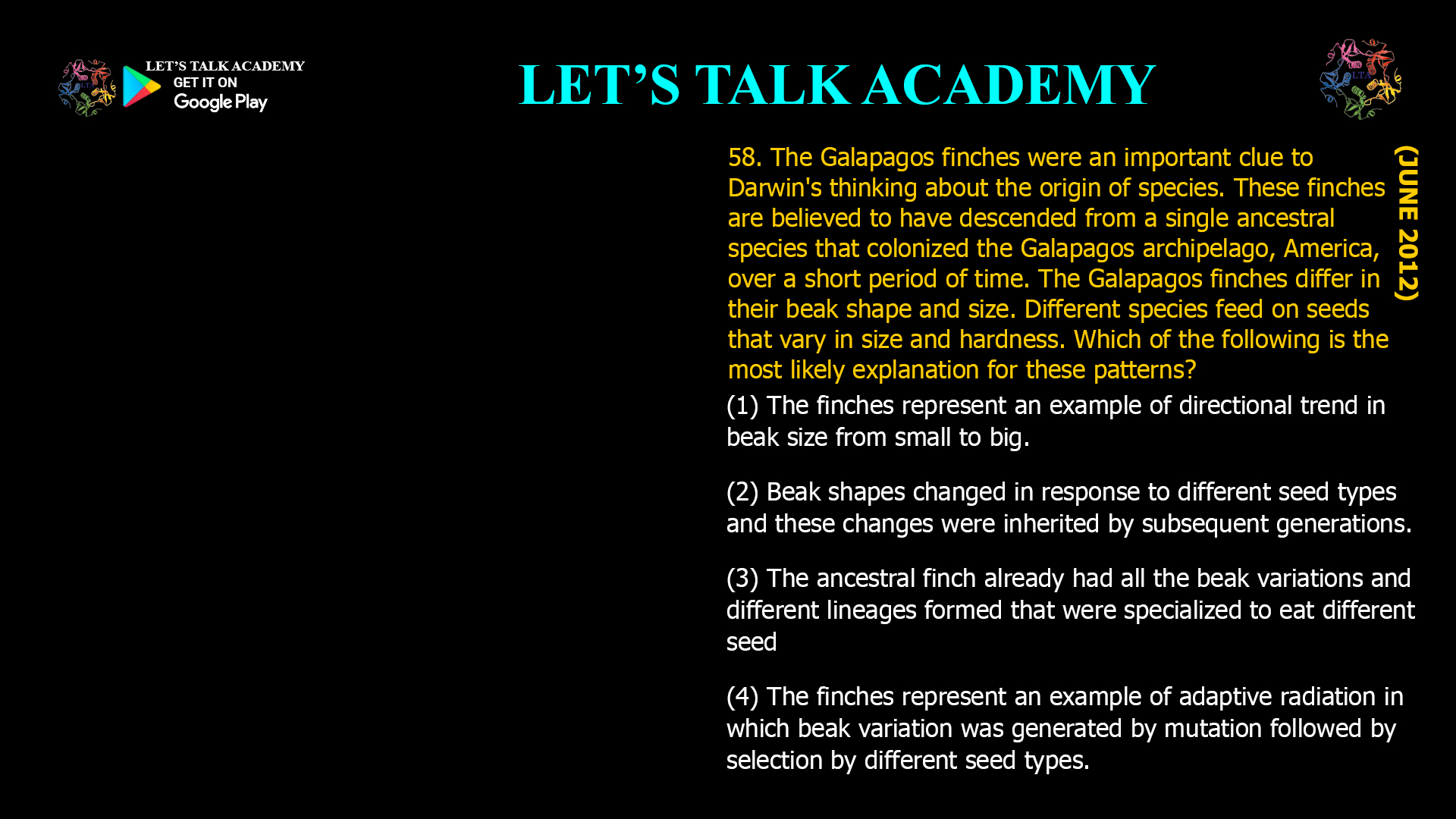- The Galapagos finches were an important clue to Darwin’s thinking about the origin of species. These finches are believed to have descended from a single ancestral species that colonized the Galapagos archipelago, America, over a short period of time. The Galapagos finches differ in their beak shape and size. Different species feed on seeds that vary in size and
hardness. Which of the following is the most likely explanation for these patterns?
(1) The finches represent an example of directional trend in beak size from small to big.
(2) Beak shapes changed in response to different seed types and these changes were inherited by subsequent generations.
(3) The ancestral finch already had all the beak variations and different lineages formed that were specialized to eat different seed
(4) The finches represent an example of adaptive radiation in which beak variation was
generated by mutation followed by selection by different seed types.The Origin of Beak Diversity
When the ancestral finch species first arrived in the Galapagos archipelago, it encountered a range of ecological niches—different islands with varying types of seeds, fruits, and insects. Over time, populations of finches became isolated on different islands or in distinct habitats, each facing unique environmental challenges and food sources.
Mutation and Natural Selection: The Engines of Change
Genetic mutations introduced variation in beak size and shape among the finch populations. Some mutations led to longer, thinner beaks ideal for probing flowers or catching insects, while others produced shorter, stronger beaks suited for cracking hard seeds. Natural selection then acted on these variations:
-
Finches with beak shapes better suited to available food sources survived and reproduced more successfully.
-
Over generations, these advantageous traits became more common within each population.
This process, known as adaptive radiation, resulted in the emergence of multiple finch species, each specialized for a particular ecological niche.
Modern Genetic Insights
Recent genetic studies have identified specific genes, such as ALX1, BMP4, and calmodulin, that play crucial roles in determining beak shape and size. Mutations and variations in these genes, followed by selection for traits best suited to local food sources, drove the rapid diversification of the finches.
Why Adaptive Radiation Is the Best Explanation
Among the possible explanations for the patterns observed in Galapagos finches:
-
Directional trends (option 1) do not account for the diversity of beak shapes and sizes; the change is not simply from small to big.
-
Inheritance of acquired traits (option 2) is not supported by modern genetics; changes are not directly caused by use or disuse.
-
Pre-existing variation in the ancestor (option 3) is insufficient, as most beak diversity arose after colonization via mutation and selection.
-
Adaptive radiation via mutation and selection (option 4) best explains the observed patterns: new mutations generated variation, and natural selection favored those best adapted to different food types.
Conclusion
The Galapagos finches exemplify adaptive radiation, where mutation and natural selection in response to diverse ecological opportunities produced a wide range of beak shapes and sizes. This evolutionary process, observable both in the field and at the genetic level, remains one of the most compelling demonstrations of how new species arise and diversify.
Correct answer:
(4) The finches represent an example of adaptive radiation in which beak variation was generated by mutation followed by selection by different seed types. -




2 Comments
Manisha choudhary
October 5, 2025The finches represent an example of adaptive radiation in which beak variation was generated by mutation followed by selection by different seed types.
Sonal Nagar
November 14, 2025The finches represent an example of adaptive radiation in which beak variation was generated by mutation followed by selection by different seed types